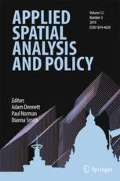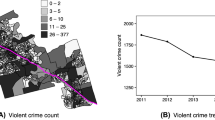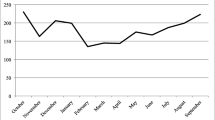Abstract
City-driven open data initiatives have made spatially referenced crime and risk factor data more readily available online, allowing for significance tests to determine the relationship between environment and crime. This paper uses a variety of open source data to assess risk factors for specific violent crime types (assault, homicide, rape, robbery) in three different cities. The results contribute to our understanding of 1) variation in intra-city risk factors for each violent crime type, 2) the degree of spatial overlap for high-risk places for each violent crime type within a city, and 3) the generalizability of risk factors across crime types and cities. Risk Terrain Modeling (RTM) was used to determine the risk factors associated with each crime type at the micro-level and conjunctive analyses of case configurations (CACC) determined the unique behavior settings at the highest risk for each specific violent crime in each city. The findings indicate that intra-city risk factors vary greatly for each violent crime, highrisk places for different violent crimes tend to not overlap spatially within a city, and risk factors are not generalizable across crime types or across cities. Researchers and law enforcement need to examine local, crime-specific contexts when assessing crime problems and generating solutions.



Similar content being viewed by others
Notes
A more complete discussion of RTM, including the associated methods and relevant literature, will be highlighted in “Risk Terrain Modeling” section.
There are three primary reasons these cities were selected for the present analysis. The first reason was data availability, since this analysis was comprised largely of publicly available data each respective city had to maintain an updated and robust open data portal. Second, the similarities in population size and recent city growth make them more readily amenable for comparison. We often use population size as a proxy measure for general similarity in city-level research. Third, the differing regions rules out the cities having a mutual influence on one another’s functioning that may introduce issues of collinearity. Cities that are geographically closer together may create dependent outcomes.
Airport boundaries were included for Denver and Indianapolis because these airports are policed by designated units within the local police department. The crime data obtained from the study is from the same agency that polices the airport for these two cities. In DC, the airport falls outside the boundaries of DC and is not policed by the DC police department (it is policed by the Metropolitan Washington Airport Authority). Resultantly, the airport and its crime data were not included in the DC analyses.
The Infogroup risk factors included in the study were: ATM’s, banks, bars, check-cashing/payday loans, liquor stores, nightclubs/lounges, and restaurants.
The only discrepancy in the risk factor data is the use of three semi-interchangeable proxy measures. Abandoned/foreclosed buildings were used for Indianapolis, the Denver data was limited to foreclosures only, and the Washington, D.C. analysis only included buildings listed as vacant/abandoned.
Hotels and motels were operationalized as separate constructs due to the differences in design, with hotels often having more floors and rooms whereas motels generally have one to two floors and may provide longer term living options and often are characterized by lower rates.
The result presentation for the intra-city risk factor variation assessments is largely a-contextual due to the primary aim of the study. The present study is interested in determining if the same risk factors are significant when changing the crime type and the city as opposed to delving further into why each risk factor is significant and what the potential relationship between the risk factor and the outcome might be. Future research should examine some of the potential explanations regarding why certain risk factors only influence specific crime types or specific cities, and should strive to create risk narratives (Caplan and Kennedy 2016).
References
Andresen, M., & Linning, S. (2012). The (in)inappropriateness of aggregating across crime types. Applied Geography, 35(2012), 275–282.
Andresen, M., Curman, A., & Linning, A. (2017). The trajectories of crime at places: Understanding the patterns of disaggregated crime types. Journal of Quantitative Criminology, 33(3), 427–449.
Barnum, J., Caplan, J., Kennedy, L., & Piza, E. (2017). The crime kaleidoscope; a cross-jurisdictional analysis of place features and crime in three urban environments. Applied Geography, 79, 203–211.
Bernasco, W., & Block, R. (2011). Robberies in Chicago: A block-level analysis of the influence of crime generators, crime attractors, and offender anchor points. Journal of Research in Crime and Delinquency, 48(1), 33–57.
Braga, A. A., Hureau, D., & Papachristos, A. V. (2012). An ex post facto evaluation framework for place-based interventions. Evaluation Review, 35(6), 592–626.
Brantingham, P. L., & Brantingham, P. J. (1993). Nodes, paths and edges; considerations on the complexity of crime and the physical environment. Journal of Environmental Psychology, 13(1), 3–28.
Brantingham, P., & Brantingham, P. (1995). Criminality of place. European Journal of Criminal Policy and Research, 3, 5–26.
Brantingham, P., & Brantingham, P. J. (2008). Crime pattern theory. In R. Wortley & L. Mazerolle (Eds.), Environmental criminology and crime analysis. New York: Routledge.
Burgason, K., Drawve, G., Brown, T., & Eassey, J. (2017). Close only counts in alcohol and violence: Controlling violence near late-night alcohol establishments using a routine activities approach. Journal of Criminal Justice, 50, 62–68.
Caplan, J., & Kennedy, L. (2011). Risk terrain modeling compendium: For crime analysis. Newark: Rutgers Center on Public Security.
Caplan, J. M., & Kennedy, L. W. (2016). Risk terrain modeling. In Crime predictions and risk reduction. Oakland: University of California Press.
Caplan, J. M., & Kennedy, L. W. (2018). Risk terrain modeling diagnostics (RTMDx) version 1.5. Newark: Rutgers Center on Public Security.
Caplan, J., Kennedy, L., Barnum, J., & Piza, E. (2017). Crime in context: Utilizing risk terrain modeling and conjunctive analysis of case configurations to explore the dynamics of criminogenic behavior settings. Journal of Contemporary Criminal Justice, 33(2), 133–151.
Clarke, R. V. (1980). Situational crime prevention theory and practice. British Journal of Criminology, 20(2), 136–147.
Clarke, R. V. (1997). Situational crime prevention: Successful case studies. Albany: Harrow and Heston.
Clarke, R. (2013). Situational crime prevention. In R. Wortley & L. Mazzerole (Eds.), Environmental criminology and crime analysis. Willan: Milton.
Cohen, L. E., & Felson, M. (1979). Social change and crime rate trends: A routine activity approach. American Sociological Review, 44, 588–605.
Connealy, N., & Piza, E. (2019). Risk factor and high-risk place variations across different robbery targets in Denver, Colorado. Journal of Criminal Justice, 60, 47–56.
Drawve, G., & Barnum, J. (2018). Place-based risk factors for aggravated assault across police divisions in Little Rock, Arkansas. Journal of Criminal Justice, 41(2), 173–192.
Felson, M., & Clarke, R. (1998). Opportunity makes the thief: Practical theory for crime prevention. Police Research Series, 5–18 (paper 98. London).
Gerell, M. (2018). Bus stops and violence, are risky places really risky? European Journal on Criminal Policy and Research, 24(4), 351–371.
Graham, K., Bernards, S., Osgood, W., & Wells, S. (2006). Bad nights or bad bars? Multi-level analysis of environmental predictors of aggression in late-night large-capacity bars and clubs. Addiction, 101(11), 1569–1580.
Groff, E., & McCord, E. S. (2011). The role of neighborhood parks as crime generators. Security Journal, 25(1), 1–24.
Haberman, C. (2017). Overlapping hot spots? Criminology & Public Policy, 16(2), 633–660.
Hart, T. C., & Miethe, T. D. (2015). Configural behavior settings of crime event locations: Toward an alternative conceptualization of criminogenic microenvironments. Journal of Research in Crime and Delinquency, 52, 373–402.
Heffner, J. (2013). Statistics of the RTMDx utility. In J. Caplan, L. W. Kennedy, & E. Piza (Eds.), Risk terrain modeling diagnostics utility user manual: Version 1.0. Newark: Rutgers Center on Public Security.
Kennedy, L. W. (1983). The urban kaleidoscope: Canadian perspectives. New York: McGraw-Hill Ryerson Limited.
Kennedy, L., Caplan, J., Piza, E., & Buccine-Schraeder, H. (2016). Vulnerability and exposure to crime: Applying risk terrain modeling to the study of assaults in Chicago. Applied Spatial Analysis and Policy, 9(4), 529–548.
Kypri, K. (2015). Evidence of harm from late night alcohol sales continues to strengthen. Addiction, 110(6), 965–966.
Lersch, K. (2017). Risky places: An analysis of carjackings in Detroit. Journal of Criminal Justice, 52, 34–40.
Lum, C., Koper, C. S., & Telep, C. W. (2011). The evidence-based policing matrix. Journal of Experimental Criminology, 7(1), 3–26.
Lum, C., Koper, C. S., Wu, X., Johnson, W., & Stoltz, M. (2018). The proactive policing lab. Final report to the Laura and John Arnold Foundation. Fairfax: George Mason University.
Miethe, T. D., Hart, T. C., & Regoeczi, W. C. (2008). The conjunctive analysis of case configurations: An exploratory method for discrete multivariate analyses of crime data. Journal of Quantitative Criminology, 24, 227–241.
Piza, E., & Gilchrist, A. (2018). Measuring the effect heterogeneity of police enforcement actions across spatial contexts. Journal of Criminal Justice, 54, 76–87.
Sampson, R. J. (2012). Great American city: Chicago and the enduring neighborhood effect. Chicago: University of Chicago Press.
Scribner, R., Cohen, D., Kaplan, S., & Allen, S. (1999). Alcohol availability and homicide in New Orleans: Conceptual considerations for small area analysis of the effect of alcohol outlet density. Journal Studies on Alcohol, 60(3), 310–316.
Shaw, C. R., & McKay, H. D. (1942). Juvenile delinquency in urban areas. Chicago: University of Chicago Press.
Szkola, J., Piza, E., & Drawve, G. (2019). Risk terrain modeling: Seasonality and predictive validity. Justice Quarterly, 1–22. https://doi.org/10.1080/07418825.2019.1630472.
Valasik, M. (2018). Gang violence predictability: Using risk terrain modeling to study gang homicides and gang assaults in East Los Angeles. Journal of Criminal Justice, 58, 10–21.
Valasik, M., Brault, E., & Martinez, S. (2019). Forecasting homicide in the red stick: Risk terrain modeling and the spatial influence of urban blight on lethal violent in Baton Rouge. Social Science Research: Louisiana.
Weisburd, D. (2015). The law of crime concentration and the criminology of place. Criminology, 53(2), 133–157.
Weisburd, D., Groff, E., & Yang, S. (2012). The criminology of place: Street segments and our understanding of the crime problem. Oxford: Oxford University Press.
Weisburd, D., Telep, C., Braga, A., Cave, B., Bowers, K., Eck, J., & Hinkle, J. (2016). Place matters. Cambridge University Press.
Wright, R. T., & Decker, S. H. (1997). Armed robbers in action: Stickups and street culture. Lebanon: Northeastern. University Press.
Wright, R., Logie, R., & Decker, S. (1995). Criminal expertise and offender decision making: An experimental study of the target selection process in residential burglary. Journal of Research in Crime and Delinquency, 32(1), 39–53.
Author information
Authors and Affiliations
Corresponding author
Additional information
Publisher’s Note
Springer Nature remains neutral with regard to jurisdictional claims in published maps and institutional affiliations.
Rights and permissions
About this article
Cite this article
Connealy, N.T. Can we Trust Crime Predictors and Crime Categories? Expansions on the Potential Problem of Generalization. Appl. Spatial Analysis 13, 669–692 (2020). https://doi.org/10.1007/s12061-019-09323-5
Received:
Accepted:
Published:
Issue Date:
DOI: https://doi.org/10.1007/s12061-019-09323-5




